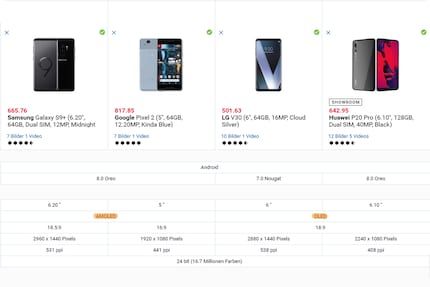
Background information
Samsung QLED revolution: what is Quantum Dot OLED?
by Luca Fontana

LG produces OLEDs for TVs, Samsung for most smartphones. The same seems to apply: AMOLED is the OLED of smartphones. That's nonsense. Here you can find out what AMOLED really means and how the myth came about in the first place.
We all agree: OLED screens, i.e. those with organic light-emitting diodes, are ahead in the race for the technology with the best screen quality. This applies not only to televisions, but also to smartphones.
By "we" I mean the digitec editorial team. More precisely, Team "Thor", because smartphones and home cinema fall under our remit. AMOLED is a recurring topic in our editorial team meetings. Or the myth that AMOLED is a smartphone-exclusive technology. The mobile phone OLED, so to speak, or even Samsung's own creation (I've heard that too).
Time to clear up the misunderstanding. What exactly does AMOLED mean and why did the myth arise in the first place? Spoiler: Samsung is to blame. Probably.
To understand AMOLED, you need to know how OLED screens work. If you already know, just skip this part and read on from the chapter "We need electricity...".
Simplified, screens consist of two components:
In LCDs, it is liquid crystals that produce the image. The backlight, on the other hand, comes from LEDs, i.e. conventional light-emitting diodes.
This works differently with OLEDs. The image is generated by organic material. When energised, it shines so brightly that backlighting is no longer required. Hence the term "organic light-emitting diode", or OLED.
The word "organic" is often misinterpreted, however, because in German it is equated with "biological" or "natural". In chemistry, the English "organic" means carbon-containing, which means that carbon-containing compounds are used in OLED displays - not biological ones.
Every television consists of a pixel structure. For the sake of simplicity, you can think of it like a chessboard where each square is a pixel. The more squares there are on the display surface, the higher the resolution and the sharper the image.
The big advantage of OLED over LCD is that each pixel can switch itself on and off like a lamp. To do this, the power supply is simply cut to the pixel that should no longer emit light.
The question that now arises is: How does the power get to the respective pixel?
There are basically two ways in which electricity can reach the respective OLED pixel.
What is a substrate? Think of it this way: In both the active and passive matrix, the entire construct is held together like a sandwich by two layers of glass. The substrate is the carrier, i.e. the bottom layer of glass. This is the layer that you can't see when you look at your TV or smartphone.
Now to the active matrix. Here, the cathodes and anodes are not arranged in columns or rows. Instead, to put it simply, they are distributed across the entire screen in a chessboard shape. This means that each OLED pixel has its own cathode and anode. A thin-film transistor arrangement is placed on the substrate so that these can still be energised.
For the sake of simplicity, I have only drawn the bottom two layers of a pixel, i.e. the substrate and the transistor matrix. The anodes, the organic layers and the cathodes would be placed on top of these layers. I'll show that on the drawing after next.
The thin-film transistors supply each individual pixel with power or cut it off if the pixel should not light up.
The "AM" or "PM" in front of "OLED" merely describes how the individual OLED pixels are controlled - with an active or passive matrix. The joke of the whole thing: smartphones and TVs only work with the active matrix, which is why every OLED TV is also an AMOLED TV.
Why is that the case? The production of PMOLED screens is simple and inexpensive. However, due to the simple scheme, in which only entire cathode or anode strips are energised, precise control of the individual pixels in between is complicated, if not impossible. Especially with the complex, moving images that smartphones and televisions have to display at high repetition frequencies.
Another drawback: the passive matrix requires much more power than the active matrix. This means that the organic material burns out more quickly and at some point no longer lights up at all - resulting in burn-in.
PMOLED displays are therefore only used in screens that are no larger than two to three inches because power consumption is not an issue there. For example, in some sports watches or MP3 players. Anything larger has an active matrix.
You see: nothing here is smartphone-exclusive.
So why this myth that AMOLED is something exclusive to smartphones? I suspect Samsung. In my opinion, they are deliberately causing confusion, or at least not really interested in clearing up the misunderstanding.
AMOLED is a display technology and stands for Active Matrix Organic Light Emitting Diodes. It is a type of OLED display and is used in smartphones.
But the theory goes like this:
The market leader in the TV industry is LG Display. They supply all manufacturers that sell OLED televisions - including Sony and Philips. Samsung also conducted research into OLED televisions, but left the field around five years ago. Since then, they have consistently focussed on the further development of LCD technology and call it "QLED".
What now? Here's what I've noticed:
When Samsung markets its OLED products, they always precede the abbreviation "OLED" with the two letters "AM". This is redundant because all OLED smartphones or televisions are AMOLEDs, but it conveniently gives the impression that they have developed their very own technology that has nothing to do with OLED televisions.
Samsung promotes the term AMOLED - and more recently Super AMOLED - on its own products as if it were its own invention.
So if you don't know what AMOLED means, you could easily get the idea that AMOLED is different from OLED. What's more. The suspicion could arise that AMOLED is something exclusive to smartphones or even Samsung. Voilà: problem solved.
What do you think?
I write about technology as if it were cinema, and about films as if they were real life. Between bits and blockbusters, I’m after stories that move people, not just generate clicks. And yes – sometimes I listen to film scores louder than I probably should.
Interesting facts about products, behind-the-scenes looks at manufacturers and deep-dives on interesting people.
Show all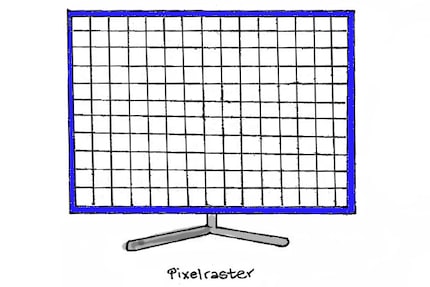
The passive matrix is based on a simple scheme consisting of stripes that are at right angles to each other. The upper strips are cathodes, while the lower ones are anodes. These are energised: current flows in through the cathodes and out through the anodes - an electrical circuit is created. In between is the organic material, which begins to glow as soon as it is energised. The whole thing sits on a substrate.
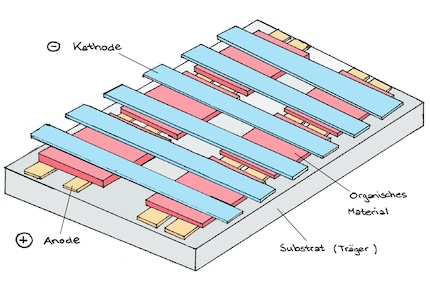
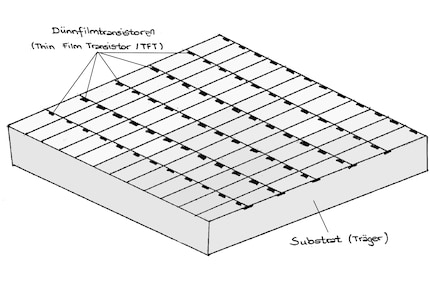
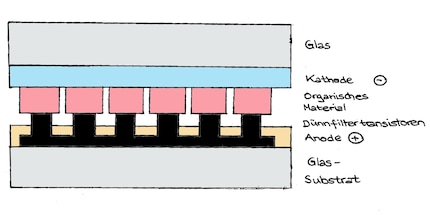
It is of course true that AMOLED is an OLED technology that is used in smartphones. But the fact that OLED televisions also rely on AMOLED displays is deliberately left out. It's almost as if Samsung didn't want too many people to know that televisions also rely on an active matrix. And yes, I'm certainly not making any friends with the South Korean manufacturer with a statement like that.
What you may not know is that Samsung still produces OLED displays, but only for smartphones. They have such a strong market position there that they even supply the apple competition from California. So if you buy an iPhone, Samsung earns a lot of money. Last year, analysts estimated that Samsung earned more from the iPhone X than from its own Galaxy S8.
The problem: Although the OLED business is extremely lucrative for Samsung - despite a slight decline in profits this year - they are not allowed to peddle it too much. On the one hand, they are big in the OLED business with flagship smartphones and earn a lot of money with them, but on the other hand, they hardly miss an opportunity to badmouth OLED televisions.


But it doesn't just look like this on the Samsung homepage. Samsung passes on the product specifications to the retailers, who then incorporate them one-to-one into their product descriptions. For example, you will also find smartphones with AMOLED or OLED displays under "Screen technology" - although basically the same technology is used everywhere under a different name.
